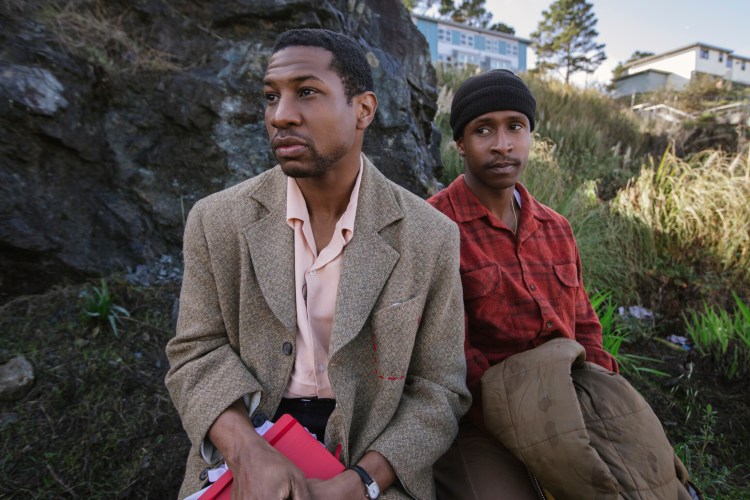“The Last Black Man in San Francisco” opens in a San Francisco a long way from the “summer of love,” and miles from the trolly cars, Fisherman’s Wharf and Lombard Street, on a block the tour buses avoid.

The first thing we see is a little black girl in a party dress and Mary Janes, watching men in hazmat suits, walking a street beside her, picking up litter.
A block away, a young bow-tied street preacher stands atop an apple box, and as the famous fog rolls in around him, harangues a few onlookers.
“How come,” he shouts, “they get to wear hazmat suits and we, who grew up here, live here every day, don’t get one?”
There are three characters in director and co-writer Joe Talbot’s magic trip through the city by the bay. First is Jimmie Fails (Jimmie Fails who co-wrote, playing himself) a hospice nurse and dreamer.
Even in his early 20s, Jimmie skirts around the city on a beaten-up skateboard with the second character, his best friend, Montgomery (Jonathan Majors) tagging along, sometimes sharing the board.
Monty, who sells fish on the wharf, is a big man with eyes full of permanent tears. He is, perhaps, an autistic thinker. Monty sports an old camel hair jacket and carries a red leather note book full of incredible sketches of the city and its people, and lines for a one-man, one-act play he adds to each night.
Stay connected to Monty, for in the final moments of the film, he will change and leave you breathless with an Oscar-stamped performance.
The third character is a Victorian candy cake house in the Fillmore District that Jimmie believes his grandfather built in 1946, when he returned from the war.
It’s clear to everyone, the neighbors, the current residents and the realtor who lists it, that it was built somewhere in the 19th century. It stands there throughout the film full of stained glass and gorgeous carved bannisters, like a displaced dowager from the 19th century, paid for by John Sutter’s gold and now selling for $4 million bitcoins.
Jimmie and Monty go to the house weekly and touch it up with paint, trim the bushes and sweep it down as though it were theirs.
The middle-age couple who live there throw rocks and fruit at them and threaten to call the police if they don’t stop. The boys pull back, but not for long.
When the couple lose their lease and are forced to move out, Jimmie and Monty seize the moment, move in under cover of darkness and fill it with all the furniture of Jimmie’s childhood he has kept stored at his sister’s house. Voila! A childhood dream doll house complete with a massive theater organ.
Jimmie and Monty are not homeless vagrants; they are the tuned-up great-grandchildren of John Steinbeck’s “Tortilla Flat” and “Grapes of Wrath,” displaced wanderers hungry for stability.
The boys are surrounded by diamond bright Federico Fellini characters: blind grandpa Allen (Danny Glover), a naked bus bench sitter with a great old hat, a blind man who sings arias to passersby, a friend who drives around and sleeps in a windowless car decorated with Christmas lights.
There is joy here in the childlike dreams of Jimmie, and in the last scene is Monty’s one-act play for neighbors up in an improvised theater in the attic. It’s called, yes, “The Last Black Man in San Francisco.” Hold on, as the incredible Jonathon Majors as the quiet Monty takes the stage and explodes in Shakespearean fury, leaving his audience and all of us shaking. It’s Oscar time for Majors.
Joe Talbot and Jimmie’s debut offering is a delightful surprise, packaged full of magic tricks, stellar performances and Adam Newport-Berra’s amazing cinematography. “The Last Black Man in San Francisco” will surely follow Barry Jenkins Oscar-winning “Moonlight.”
J.P. Devine, of Waterville, is a former stage and screen actor.
Copy the Story LinkSend questions/comments to the editors.



Success. Please wait for the page to reload. If the page does not reload within 5 seconds, please refresh the page.
Enter your email and password to access comments.
Hi, to comment on stories you must . This profile is in addition to your subscription and website login.
Already have a commenting profile? .
Invalid username/password.
Please check your email to confirm and complete your registration.
Only subscribers are eligible to post comments. Please subscribe or login first for digital access. Here’s why.
Use the form below to reset your password. When you've submitted your account email, we will send an email with a reset code.